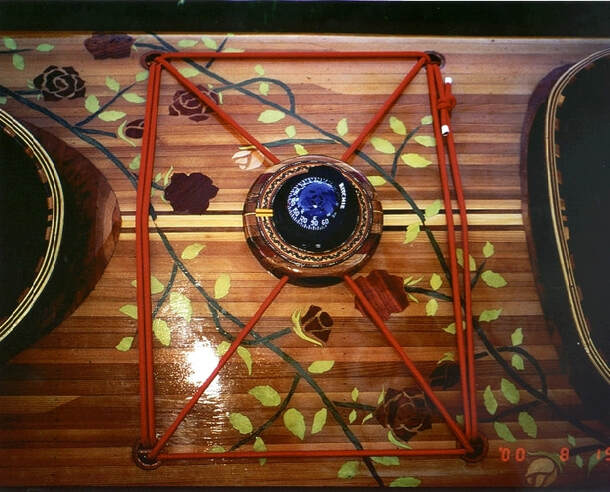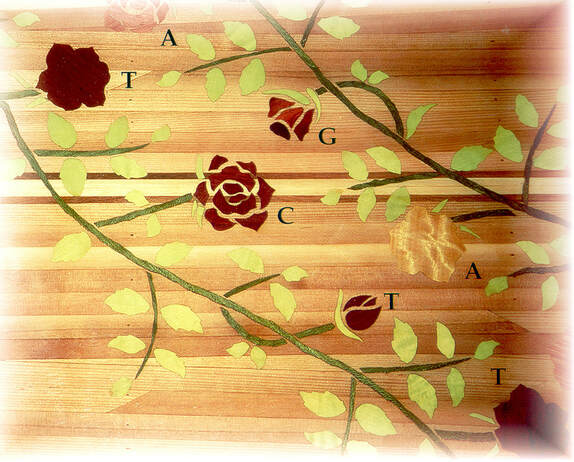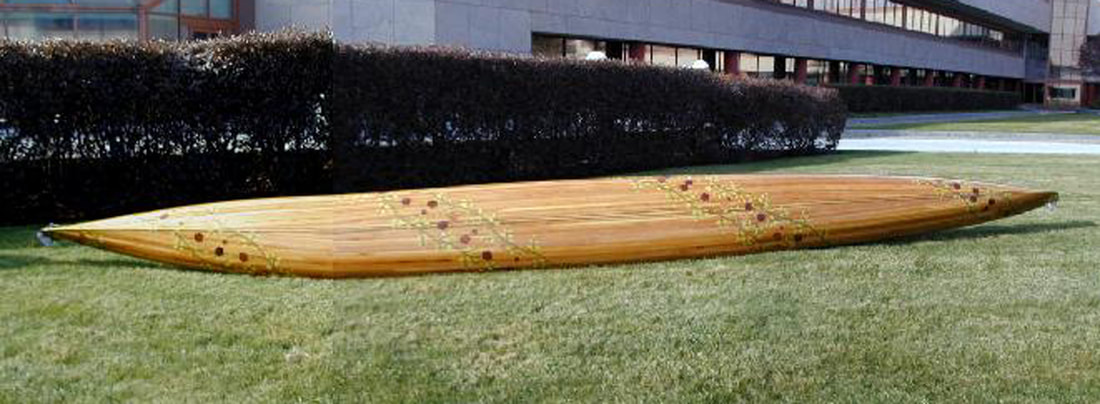Decoding the Rose Vine
The Double Helix
Flagship Boat for the Great Mississippi River Race forRett Syndrome 2001

The Double Helix was built in honor of Amanda Eid and all of those who have Rett Syndrome, to serve as a the flagship for the Great Mississippi River Race for Rett Syndrome, May 2001. The Double Helix was paddled by Clark Eid ( Amanda Eid's father, and chairman of this charity event) and Kurt Zimmermann during the race.
The Double Helix was publicly placed at the world-class Morial Convention Center in New Orleans from 2006 to 2017. In 2018, the Double Helix flagship was moved to a new museum on the river in Tennessee - the Tunica Museum - so that we can continue to raise awareness of Rett Syndrome to the general public.
Rose Vine/Double Helix Design - Amanda's Dreamkeeper
The rose vine that wraps completely around the Double Helix was designed by Clark Eid to mirror a segment of double-stranded DNA that codes for a peptide that spells "Amanda's Dream Keeper", in honor of his daughter, Amanda, who suffers from Rett Syndrome.
This mural was created by using over 2,000 pieces of 63 different wood veneers in a technique known as marquetry. Two rose vines can be seen wrapping completely around the Double Helix. This mural was created by using over 2,000 pieces of 63 different wood veneers in a technique known as marquetry.
For most people, the result was only a beautiful arrangement of flowers. However, the vines represented far more than what meets the eye.
The rose vine was designed by Clark Eid to mirror a segment of double-stranded DNA that codes for a peptide that spells "Amanda's Dreamkeeper", in honor of his daughter, Amanda, who suffers from Rett syndrome.
It wasn't coincidental that the two rose vines spiraled around the Double Helix in a right handed configuration. Nor was it by chance that all 120 roses were arranged into 60 pairs. This floral arrangement was designed to mirror a segment of double stranded DNA.
Furthermore, a special message could be deciphered from this small section of genetic code. How can this be done?

The key to solving this puzzle is to figure out which of the four bases a rose stands for, then to use the standard rules for transcribing and translating the resulting codons to the gene's protein product.
Perhaps the most prominent clue is found within the types of woods used for the roses. Note that one rose of each pair was fashioned from Purple Heart wood. Obviously, this must represent the bases with the most blue shifted (hypsochromic) uv absorption; the pyrimidines Thymine (T) and Cytosine (C)!
The puzzle could now be solved if you anticipated that the DNA segment began with the start codon ATG and ended with one of three stop codons, in this case TAA.
If this missed your attention, a further clue is found in the sepals, which are the small leaves directly below each rose.
Two sepals beneath a rose stand for two hydrogen bonds, found in an Adenine (A)-Thymine (T) pair whereas three sepals represent three hydrogen bonds, or a Guanine (G)-Cytosine (C) pair.
All that remains is to identify the template strand (vine) and write down the code.
This vine is the one that passes between the compass and the rear cockpit, growing toward the bow in the 5' to 3' direction, of course.

3'-TAC-CGG-TAC-CGG-TTA-CTA--CGG--AGA--CTA-GCG--CTT-CGG-TAC-TTT--CTT--CTT-GGA-CTT-GCG--ATT-5'
5'-ATG-GCC-ATG-GCC-AAT--GAT-GCC--TCT--GAT-CGC--GAA-GCC-ATG-AAA--GAA-GAA-CCT-GAA-CGC-TAA-3'
This DNA sequence is transcribed into mRNA, resulting in the following sequence:
5'-AUG-GCC-AUG-GCC-AAU-GAU-GCC-UCU-GAU-CGC-GAA-GCC-AUG-AAA-GAA-GAA-CCU-GAA-CGC-UAA-3'
Following the usual rules that apply for translation gives a short peptide of 18 amino acids. (See table below):
|
Rett Syndrome Rett syndrome is a severe neurological disorder that randomly strikes 1 in 10,000 young girls within the first two years of life. Rett Syndrome also affect males, but few are known to survive to pregnancy. After an apparently normal 6-18 months of development, a typical Rett syndrome child begins to suffer the loss of speech and the ability to walk normally. This is soon followed by the loss of purposeful hand use which is often replaced by hand wringing or clapping. More symptoms may develop, including seizures, severe apraxia, autistic behavior, breathing dysfunctions, spasticity and prolonged QT syndrome (a cardiovasular condition) and multiple developmental delays. An unusual X-linked genetic mutation (MECP2) was recently discovered that accounts for most Rett syndrome cases. Rett syndrome can affect any child in any family. Current statistics show over 99% of those affected by Rett syndrome have no case history of Rett syndrome in their family. There is no cure. Therapies to improve the quality of life remain elusive. For those living with Rett Syndrome,our best hope for a future free from disabilities is through research |
|
|||||||||||||||||||||||||||||||||||||||||||||||||||||||||||||||||||||
|
To "decode" the mRNA, begin with the first codon after the Start codon, AUG. Locate the codon in the table and you'll see it corresponds to an amino acid. Stop decoding when you reach the Stop codon, UAA. For example, the first codon after the Start codon is GCC which corresponds to Alanine, abbreviated by the letter "A". This is the first letter of the message......the rest of the sequence is decoded codon by codon as follows:
As you see, the peptide, when abbreviated, spells out Amanda's Dreamkeeper. It's a small exercise, but it carries a big message about our children's "Dreamkeepers", the researchers who will liberate them from their disease. (To learn more about reading DNA code, please visit the DNA Learning Center web site: Gene Almanac from Cold Spring Harbor Laboratory! This website includes "DNA from the Beginning" and more.......) |

